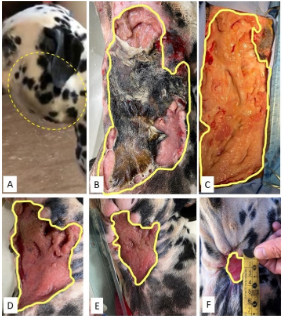Grape seed oil in the treatment of severe wound in a dog - case report
DOI:
https://doi.org/10.21708/avb.2024.18.1.12020Abstract
The aim of this study is to describe, for the first time, the use of grape seed oil in the treatment of a severe wound in a dog. A 10-year-old Dalmatian female dog presented with an abscess in the cervical region that progressed to cutaneous necrosis, resulting in a large wound. Samples were collected for culture and antimicrobial sensitivity testing (TSA). Staphylococcus pseudointermedius and multidrug-resistant Escherichia coli were isolated from the wound. The lesion was surgically debrided, and topical treatment with grape seed oil was initiated. The patient was followed until complete healing, which occurred in 28 days. The wound area was measured at seven-day intervals until complete healing (D0, D7, D14, D21, and D28), with the respective measurements being 11204.8 mm2, 4348.0 mm2, 2414.9 mm2, 120.2 mm2, and 0.00 mm2. The wound contraction potential was calculated for the intervals of 0 to 7, 7 to 14, 14 to 21, and 21 to 28 days, and it was -61.19%, -44.45%, -95.02%, and -100.00%, respectively. The complete healing of the wound at 28 days post-debridement indicates that grape seed oil is an alternative for wound treatment in dogs.
Downloads

Downloads
Pubblicato
Fascicolo
Sezione
Licenza
Copyright (c) 2024 Acta Veterinaria Brasilica

TQuesto lavoro è fornito con la licenza Creative Commons Attribuzione 4.0 Internazionale.
Autores que publicam na Acta Veterinaria Brasilica concordam com os seguintes termos: a) Autores mantém os direitos autorais e concedem à revista o direito de primeira publicação, com o trabalho simultaneamente licenciado sob a Licença Creative Commons Attribution que permite o compartilhamento do trabalho com reconhecimento da autoria e publicação inicial nesta revista. b) Autores têm autorização para assumir contratos adicionais separadamente, para distribuição não-exclusiva da versão do trabalho publicada nesta revista (ex.: publicar em repositório institucional ou como capítulo de livro), com reconhecimento de autoria e publicação inicial nesta revista. c) Autores têm permissão e são estimulados a publicar e distribuir seu trabalho online (ex.: em repositórios institucionais ou na sua página pessoal) a qualquer ponto antes ou durante o processo editorial, já que isso pode gerar alterações produtivas, bem como aumentar o impacto e a citação do trabalho publicado (Veja O Efeito do Acesso Livre).


 Esta obra está licenciada com uma Licença
Esta obra está licenciada com uma Licença 